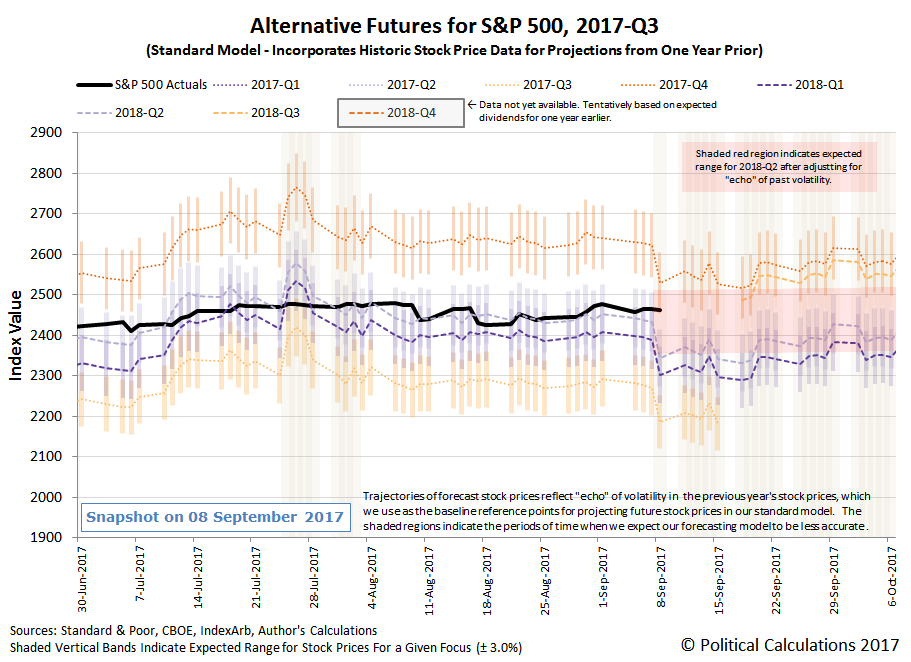National Carbon Dioxide Emissions
Visualizing the U.S. Distribution of Income in 2017
U.S-China Trade Before the Storm
Spaghetti Charts and the S&P 500’s Future in Week 1 of September 2017
After the last two weeks of seeing so many spaghetti models that forecast the potential trajectory of hurricanes in the news, we can't help but note that the forecasting charts that we show each week really represent a similar concept being applied to the future path of the S&P 500.
Only for us, the difference between the alternative trajectories that the S&P 500 might follow comes down to how far into the future investors are collectively looking at any given point in time, where the base reference points that we're projecting from are 13 months, 12 months and 1 month in the past.
That would seem to be a pretty straightforward proposition, but not always. Sometimes, the historic stock prices that we use as those base reference points reflect have been affected by an abnormal amount of volatility in the stock market, where the echo of past volatility skews our dividend futures-based model forecasts.
Last week, we entered one of those periods, which will affect the accuracy of our raw forecasts through 8 November 2017.
That's why we've adjusted our alternative futures chart for the S&P 500 by overwriting the overall trajectory in which we expect the S&P 500 to fall during the next several weeks, where we've assumed that 2018-Q2 will continue to be the point in time to which investors will focused their attention, just as they have over the last several weeks.
Our basis for making that assumption may prove to be very short-lived however. The CME Group's Fedwatch Tool no longer anticipates any change in the level of the Federal Funds Rate in the U.S. through the indefinite future (or rather, at least 1 August 2018), where other factors may soon affect how far into the future investors look.
Consequently, we may see greater volatility in the S&P 500 as a result, where breaking news may cause investors to suddenly shift their attention to other points of time in the future.
As that might happen, we'll redraw the chart to show the echo-adjusted trajectory they might settle upon. Right now however, we'll observe that will have a positive effect on the level of the S&P 500 if they focus upon 2017-Q4 or 2018-Q3, but a negative one if they have reason to focus upon 2018-Q1. Update 10:15 AM EDT: Early trading on 11 September 2017 suggests either 2017-Q4 or 2018-Q3!
And since that other kind of news may have a more significant impact on stock prices now that investors expect the Fed to sit on the sidelines, here are examples of the kinds of headlines that can drive stock prices from the last week.
- Monday, 11 September 2017
- Tuesday, 12 September 2017
- Mixed message for oil and gasoline:
- Fed policymakers signal caution on inflation, rate hikes
- Federal Reserve should be patient on rate hikes, says Kaplan
- Brainard's warning signals Fed cautious on inflation
- Fed's rate hikes may be doing real harm to U.S. economy: Kashkari
- Fed's Kaplan sticks to view that balance sheet should shrink
- Fresh North Korea tensions hit Wall Street
- Wednesday, 13 September 2017
- Thursday, 14 September 2017
- Oil mixed, Brent rises as Irma casts shadow over Harvey recovery
- Dudley stands by Fed rate hikes, still sees U.S. inflation rebound
- Wishful thinking? Weak U.S. inflation puzzle should clarify in six months: Fed's Dudley
- Fed's Mester says wants to 'set it and forget it' on balance sheet
- A preview for Hurricane Irma in Puerto Rico and Florida: Hurricane Harvey boosts U.S. jobless claims to more than two-year high
- Wall St. ends flat as media stocks slump, healthcare gains
- Friday, 15 September 2017
- Oil slides as Irma heads for Florida, threatening demand
- Throwing in the towel for a September 2017 rate hike: Too soon to predict timing of next Fed rate hike: Dudley
- S&P 500 slips as Hurricane Irma nears Florida; tech falls
For a bigger picture of the week's major economic and market news, Barry Ritholtz succinctly summarizes the positives and negatives for Week 1 of September 2017.
